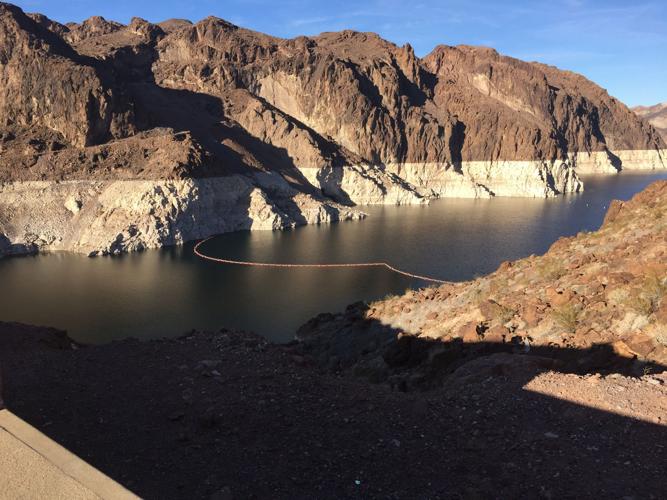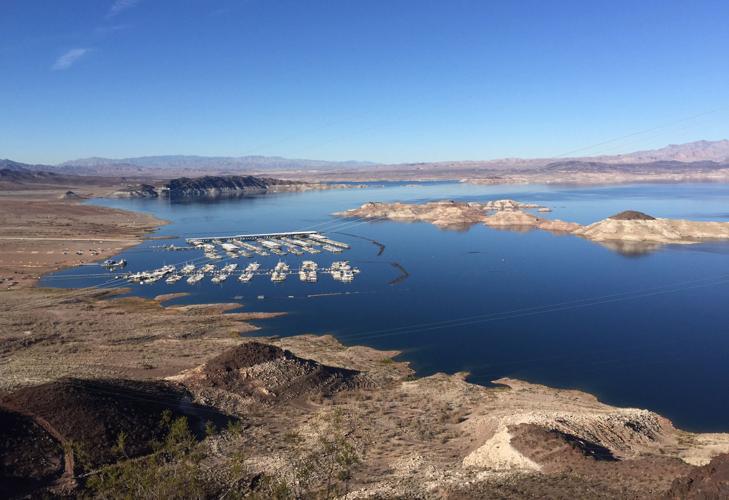LAS VEGAS — For the second time in a decade, the feds are warning that if water interests in Arizona, California and Nevada can’t find a fix for the Colorado River’s problems, the interior secretary will find it for them.
Deputy Interior Secretary Michael Connor implied that was the department’s position in a talk Friday to hundreds of water officials, farmers and others gathered in Las Vegas for the 70th annual conference of the Colorado River Water Users Association. After his speech, Connor came right out and said it in response to a reporter’s questions.
Connor talked of the need to prevent Lake Mead, about 25 miles south of Las Vegas, from falling to dangerously low levels — potentially low enough to force Draconian cutbacks in water deliveries to cities and Indian tribes in Arizona, as well as to farms. The solutions haven’t been easy to find, in large part because they would require water users, particularly cities and farms in Arizona and California, to accept smaller cuts in water deliveries soon to stave off more severe cutbacks later.
The lake has dropped more than 120 feet since 2000. It’s expected to close 2015 at 1,082 feet elevation, 5 to 6 feet lower than a year ago. The first shortage in the river would be declared at 1,075 feet, but its effects would be far less drastic than shortages declared at lower lake levels that Conner raised concerns about.
Tucson has a stake in Lake Mead because it depends more on Colorado River water than any other Arizona city that takes Central Arizona Project water from the river for drinking. Tucson is also at the end of the CAP pipeline, which has made many water officials here over the years think they could be more prone to cutoffs than other Arizona cities, although there’s no hard evidence that’s the case.
The risk is now up to 30 percent that Mead will drop to potentially dangerous levels in five years, Connor said.
“In the first six months of 2016, we have to see progress, coming together” among leaders of the three Lower Colorado River Basin states, Connor said after his talk. “I’m optimistic at the progress that we’ve made so far, but we need to be very transparent about the risks we face and think through solutions. We feel it’s very important to stay on track and get it resolved.”
He said that by the time of next year’s conference, he hopes the states will have reached agreement and that his boss, Interior Secretary Sally Jewell, will come to celebrate. If not, he said, he or Jewell may have to carry out “contingency planning” to manage the river.
Conner took essentially the same position that former President George W. Bush’s first interior secretary, Gale Norton, took in 2005 when she wrote a letter to the states warning that she would impose a solution if the states couldn’t find one. Two years later, the seven states negotiated an agreement setting guidelines for what levels of water shortages would be declared at different lake levels and how the states would share shortages.
Back then, the lake level was much higher and the risks much lower, Connor and other officials noted last week.
At the time, authorities felt the risk of the lake dropping to 1,020 feet in five years was 3 percent, he said. Now, due to continued drought and the availability of more advanced computer models, the risk is 11 percent of dropping below 1,020 in five years if climate change isn’t considered, and 30 percent if it is, Conner told the group.
“We’re committed to continuing negotiations into 2016 and thinking creatively how to implement actions to protect Lake Mead elevations,” he said.
Afterward, Colorado water users association President David Modeer said no one involved in Southwest water issues wants to see the feds impose a solution. But that may be an appropriate action “if we can’t solve it,” said Modeer, a retired CAP general manager and before that Tucson Water’s director.
“We’ve always recognized that if we can’t find cooperative agreements to address falling reservoirs, someone else will step in, and that will be the (Interior) secretary,” Modeer said.
“The Interior Department, it’s got international obligations to manage the river, clear obligations,” added John Weisheit, an environmentalist attending the conference representing the Moab, Utah, group Living Rivers.
“Those are lofty obligations, and if they don’t (follow through), it’s negligence.”
THREE POTENTIAL PROBLEMS
The river, particularly the Lower Basin, faces three potential water shortage problems rolled into one.
First, there is the short-term risk of Lake Mead dropping over the next decade to levels low enough to force severe cutbacks. Second, the Lower Basin river system faces a longer-term “structural deficit” of about 1.2 million acre-feet of water use compared to supply, which must be solved over a longer period, water officials say. Third, the entire Colorado River Basin faces a supply-demand deficit of about 3.2 million acre-feet by 2050, the Bureau of Reclamation has said.
For now, negotiators are trying to find ways to reduce water use enough to save at least 3 million acre-feet — enough to serve about 6 million homes for a year — over five years, said Terry Fulp, the reclamation bureau’s Lower Colorado regional director.
“We want to get more than that, because the risks are just higher now,” Fulp said. “Our concept is that you don’t just do it for five years, you do it through 2026. ... We’re trying to get to numbers we can agree on.”
SOLUTIONS ELUSIVE
Given the sensitivities at stake, negotiators for states are generally unwilling to discuss specific solutions being considered. But the difficulties in finding solutions aren’t hard to understand.
In an interview, Arizona Department of Water Resources Director Tom Buschatzke said the main unresolved issues are the same as he told the Senate Energy and Natural Resources Committee at a drought hearing last June:
- The California drought that’s slashed snowpack levels has reduced that state’s flexibility for accepting cuts in Colorado River deliveries.
- Many outside officials, including some in Arizona, have fingered the Imperial Irrigation District in the California desert west of Yuma as a prime target for water-use efficiencies. It has by far the largest share of river water of any user: about 2.6 million acre-feet used this year. But if Imperial Valley farmers use less water, that’s less runoff going into the already shrunken Salton Sea to the west. The Salton is an internationally recognized bird sanctuary that’s in danger of turning into a sea of toxic dust if the water keeps receding.
- California’s senior priority claim to river water compared to Arizona “has created a bit of an unlevel playing field,” Buschatzke said. Under the 1968 law authorizing CAP, during a shortage, Arizona will lose all its CAP water before California suffers cutbacks.
The Imperial district is always a target, counters Tina Shields, the district’s water manager. “When things get tough, they look at us. We’re low-hanging fruit,” added Shields in an interview at the conference.
Arizona has been contributing to the structural deficit by storing a lot of unused CAP water underground that could have been left in the river, she said.
“Yet now they say they have a problem and they want California to solve it,” she said. “For Arizona to ask California to solve the structural deficit problem, that doesn’t make sense.”
But at a panel discussion Thursday on the structural deficit, representatives of CAP and Southern California’s Metropolitan Water District didn’t portray each other as adversaries.
“I see more collaboration than animosity with Arizona,” said Bill Hasencamp, the Met’s Colorado River manager. The two states and Nevada have worked together on projects over the last decade that have put some water back in Mead, culminating in an agreement a year ago to save 745,000 acre-feet in three years.
“We have a history of cooperation that needs to continue, and we need to stop saying that one state or another must put up their fair share,” he said. “The question is, how can we collectively help a system on its way down that needs adjustments?”
California is not the enemy, agreed CAP Assistant General Manager Tom McCann, although historically it’s been easy to use such rhetoric — “that they’re the bad guy and that all our problems are because of them.”
“The truth is the junior priority in the 1968 act for Arizona has created an inequity in our position that has led to or fostered — I don’t want to say California is not willing to step up to the plate — but when you have the top priority, you can say you don’t have to do anything, because you’re in good shape,” said McCann, while acknowledging, “California has done some things.”





